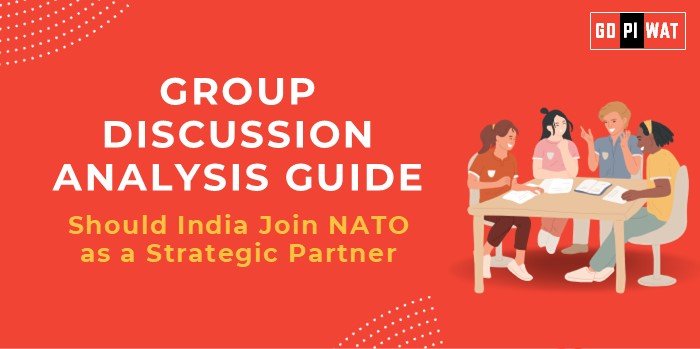📋 Group Discussion (GD) Analysis Guide: Should India Join NATO as a Strategic Partner?
🌐 Introduction to the Topic
Opening Context: In the evolving landscape of global security, the prospect of India joining NATO as a strategic partner has sparked significant debate. This discussion centers on balancing India’s traditional non-alignment policy with emerging geopolitical realities.
Topic Background: Established in 1949, NATO is a military alliance of 31 member countries. Originally focused on transatlantic security, NATO has expanded partnerships to include Indo-Pacific nations like Japan and South Korea. India’s potential partnership with NATO would represent a significant shift in its foreign policy, characterized by strategic autonomy and non-alignment.
📊 Quick Facts and Key Statistics
- NATO Members: 32 member countries, including the USA, UK, France, and Germany.
- India’s Defense Spending: $81.36 billion in 2022, the third-largest globally.
- NATO’s Global Partnerships: Collaborates with Japan, South Korea, Australia, and New Zealand to address global security challenges.
- India’s Trade Relations: The EU accounts for 11% of India’s total exports.
- China’s Military Spending: $293 billion in 2023, showcasing regional defense competition.
🏆 Achievements and Challenges
🌟 Achievements
- Enhanced Defense Capabilities: NATO partnership could provide access to advanced military technologies and joint training exercises.
- Strategic Influence: Elevates India’s role in global security discussions, especially concerning Indo-Pacific stability.
- Counterterrorism Cooperation: Shared intelligence and coordinated operations could strengthen anti-terrorism efforts.
⚠️ Challenges
- Strategic Autonomy: Joining NATO may compromise India’s non-alignment policy.
- Impact on Russia Relations: Partnership with NATO could strain ties with Russia, a key military supplier.
- Regional Tensions: China and Pakistan might perceive the partnership as a provocative move, escalating tensions.
🌍 Global Comparisons
- Japan: Balances strong economic and security ties with NATO while maintaining constitutional constraints on military engagement.
- South Korea: Focuses on cybersecurity and non-proliferation partnerships with NATO while managing regional dynamics.
📖 Case Study:
South Korea’s NATO Partnership: Enhances defense capabilities through joint exercises and information sharing while carefully navigating relations with neighboring countries.
📖 Structured Arguments for Discussion
✅ Supporting Stance:
“India’s strategic partnership with NATO could significantly enhance its defense capabilities and global standing, providing a robust framework to counter regional threats.”
❌ Opposing Stance:
“Aligning with NATO may undermine India’s strategic autonomy, strain relations with Russia, and escalate regional tensions with neighboring countries.”
⚖️ Balanced Perspective:
“While a NATO partnership offers potential benefits in defense cooperation, India must carefully weigh these advantages against risks to its non-aligned foreign policy and traditional alliances.”
🔍 Effective Discussion Approaches
Opening Techniques:
- Statistical Opening: “With India’s defense spending exceeding $81 billion annually, partnering with NATO could provide access to cutting-edge technologies and strategic expertise.”
- Contrast Approach: “While NATO seeks to extend its reach into the Indo-Pacific, India’s historical non-alignment stands as a potential barrier to such a partnership.”
- Question Opening: “Can India maintain its strategic autonomy while engaging in a deeper partnership with NATO?”
Counter-Argument Handling:
- Highlight benefits like defense technology sharing while emphasizing the need to preserve sovereignty.
- Discuss diversifying defense imports to reduce dependency on any single country, including Russia.
📖 Strategic Analysis of Strengths and Weaknesses
- Strengths: Access to advanced defense technologies, enhanced global influence, stronger counter-terrorism initiatives.
- Weaknesses: Risk of alienating Russia, public resistance to perceived Western alignment.
- Opportunities: Leadership in Indo-Pacific security, cybersecurity collaborations, and non-proliferation efforts.
- Threats: Escalation of tensions with China and Pakistan, abandoning non-alignment policies.
📚 Connecting with B-School Applications
- Real-World Applications: Examining how defense and foreign policy impact trade, economic growth, and international collaboration—key themes in international business and geopolitics.
- Sample Interview Questions:
- “What would be the strategic implications of India joining NATO?”
- “How can India balance its historical ties with Russia while engaging with NATO?”
- Insights for Students: Understanding the interplay between security alliances and economic policies for leadership in international business strategy.


